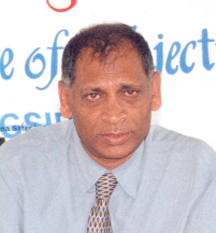In keeping with the four year national plan to tackle cervical cancer, the Health Ministry is planning a mass human papilloma virus (HPV) vaccination exercise next year aimed at young girls.
The incidence of cervical cancer remains high in the country and a National Policy and Strategy for the Prevention and Control of Cervical Cancer 2009 -2012 was recently introduced in collaboration with JHPIEGO, an affiliate of the John Hopkins University in the USA and OMNIMED of Boston.
The introduction of the HPV Vaccine Program in 2011 is important component of the strategy; the ministry is targeting girls between the ages of 9 and 11 years beginning in January 2011.

Health Minister, Dr. Leslie Ramsammy said in a statement last week that the program aims to provide vaccines for about 25,000 girls and will cost approximately $40M. However, the Ministry, through its collaboration with the IPPF and GRPA, has already mobilized the resources.
For 2012, the number of girls to be provided with Human Papilloma Virus (HPV) vaccine is expected to grow to about 40,000 and the cost is expected to increase to about $60M per year, Ramsammy noted.
The JHPIEHO Program in Guyana is headed by Dr. John Varallo who has been working as a volunteer in Guyana since 2002. The Minister noted that Dr. Varallo first came to Guyana with his colleagues from OMNIMED on his invitation to help build a program to prevent, diagnose and treat infectious diseases.
Ramsammy said that cancers represent one of the major causes of deaths and presently are ranked as the fourth main cause of death in the country, adding that approximately 450 persons die each year from it. He said that one of the most important cancers in Guyana is cervical cancer in women. Further, he said that Guyana has a cervical cancer incidence rate of about 45 per 100,000 women which means that each year about 150 to 200 women are diagnosed with cervical cancer. Presently the mortality rate associated with these cancer cases is about 20 per 100,000 women. This means that each year about 80 women die because of cervical cancer.
Research has shown that the HPV is the causative agent for more than 85% of cervical cancer. The main transmission route for HPV is through sex. The modes of transmission of this virus are similar to that of HIV. Based on this, Ramsammy said Guyana has included HPV vaccine as an important component of its national policy and strategy for prevention, diagnosis and treatment of cervical cancer.
The HPV vaccine protects against future infection and the campaign is aimed at ensuring girls are immunized against HPV before they become sexually active. The Ministry of Health said that it consulted widely and in keeping with guidelines issued by the WHO has chosen the age group of 9 to 11 years.
Screening for HPV is another important component of the strategy and according to the ministry Guyana is presently in the final stages of making arrangements to introduce the HPV test as a screening tool. The National Public Health Reference Lab will establish the capacity to test for HPV in the last quarter of 2010 and we will introduce the HPV test in 2011.
One of the marketed tests for HPV is available through QUIAGEN, an American Science Company. This test is not yet widely available in developing countries. A representative from QUIAGEN will be in Guyana from October 4th for discussion and for finalizing arrangements to introduce a form of the HPV test in 2011, the ministry added.
In addition, the ministry said that the most developed part of the National Policy and Strategy is the (Visual Inspection with Acetic Acid) VIA technology, which is already in use and almost 10,000 Guyanese women have benefitted from VIA screening in the last two years.
VIA screening is available to all women between the ages of 25 and 49, but screening will continue for women up to 59 years old. For women between the ages of 35 and 39, they should already have had a VIA screening. The Ministry said also that women with HIV should be offered VIA testing at the time when the HIV diagnosis was made.
